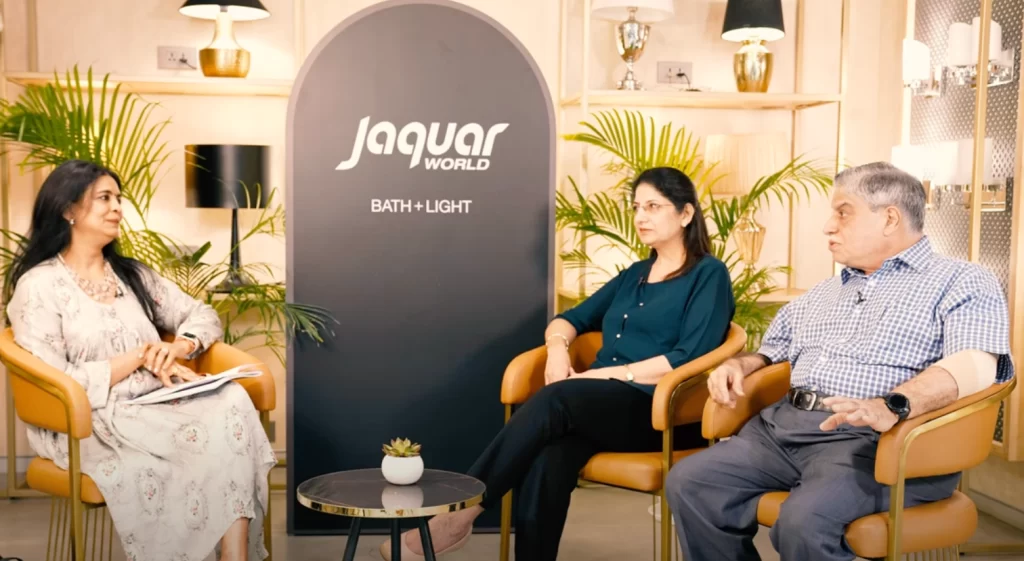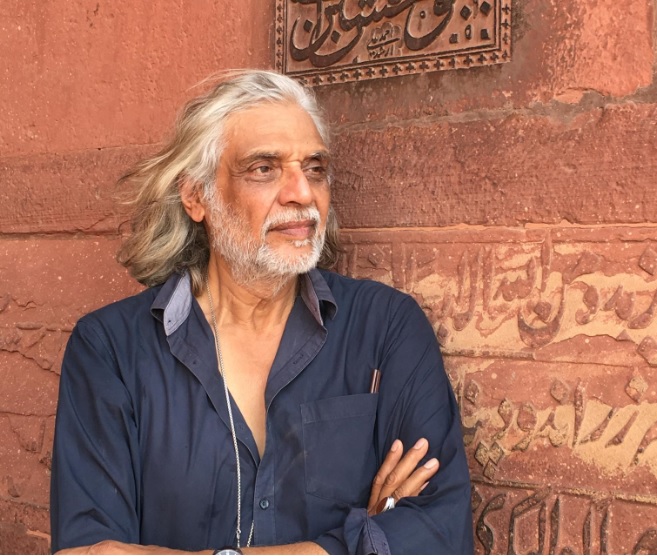Welcome to Samvaad, where art meets conversation, and inspiration knows no bounds. Here we engage in insightful conversations with eminent personalities from the art fraternity. Through Samvaad, Abir Pothi aims to create a platform for thought-provoking discussions, providing readers with an exclusive glimpse into the creative processes, inspirations, and experiences of these creative individuals. From curating groundbreaking exhibitions to pushing the boundaries of artistic expression, our interviews shed light on the diverse perspectives and contributions of these art luminaries. Samvaad is your ticket to connect with the visionaries who breathe life into the art world, offering unique insights and behind-the-scenes glimpses into their fascinating journeys.
Welcome to another insightful episode of Samvaad at Jaquar, hosted by Ruby Jagrut and brought to you by Abir Pothi. Today, the spotlight shines on a remarkable duo, Sarosh and Azmi Wadia, a married couple whose partnership extends beyond life’s boundaries into the realm of architecture. In this engaging conversation, their journey through the architectural landscape is illuminated, alongside their roles as educators and the intricate interplay between their personal and professional lives. With a rich reservoir of experience and a distinct perspective, Sarosh and Azmi offer profound insights into the evolving facets of architectural practice, the seamless fusion of teaching and real-world application, and the myriad challenges and gratifications of collaborating intimately with one’s spouse. As we delve into the lives and careers of these talented architects, their fervour and commitment to their craft become palpable, enriching our understanding of the narratives that shape our world. Thank you for joining us at Abir Samvaad, where conversations flourish and stories unfold, illuminating the tapestry of human experiences.
To read the previous parts (Click Here)
Ruby: So, you know, that is what I feel architects need to have: empathy, especially in a time of Instagram when a client is coming to you with 40 images on their phone. As you rightly said, you have to have patience and listen to him, and have that empathy towards him to give him a chance to share whatever they want to share. So whenever you’re designing a house, you know it is a very special thing for them. It’s very subjective, very private, and they come to you with a lot of aspirations.
The other day I was talking to someone, and suddenly the kitchen has become the central part of every game, you know? It is no longer a neglected space. The dressing area is no longer a neglected space. So, whenever you are designing a house, what is your take? How do you approach that blank piece of paper, seeing it take shape and become a home for somebody? How do you two together do that magically, actually, all the time?
Azmi: I think it begins with understanding the site first of all, and understanding the client’s aspirations as well.
Sorosh: Climate also plays a very important role in all our designs. Okay, so we make climate-conscious decisions about everything—where each room should be, how the wind flow will be, and so on. We understand that the clients coming to us can afford AC, yes, but we also make them realize the benefits of natural ventilation. For example, we have a big veranda at the office where our staff has lunch. We hardly use it except for occasions; the staff uses it every day and enjoys it there. Sometimes we take them out and have a meeting there, and then we say, “Suppose there’s a place like this in the house, wouldn’t you like to sit there?” But it’s non-AC because that is a major problem when we try to show him energy-conscious methods.
You know, they would ask us only about the point, “How much are they going to save?” and all that.
So, what do you say to make him aware that this is also a good place to sit? When you sit among trees and plants, then you enjoy the whole place. How do you communicate the value of these natural, pleasant spaces to encourage appreciation and usage?
Ruby: In the process, you’re not only elevating the client’s lifestyle but also making them aware and conscious of environmental issues and giving them a different experience to live with. You know, we’ve had clients where…
Sarosh: We had to actually go and give a demo of how to use the bathroom fittings—you won’t believe that, but it’s true. Back in the ’90s, with Jaquar fittings, you actually had to tell him, “This is the lever that you use for this, this is the lever for this, what a health faucet is meant for,” because they were the first ones to use the head force, you know. And we had to explain what a hand shower is used for, and that you don’t have to wash your feet in the washbasin. We’ve got all kinds of clients: Hindus, Muslims, Christians, and Parsis. Yeah, the Parsis are the most demanding, difficult people to work with—very difficult. Doctors and Parsis both are very difficult, okay?
Ruby: So, being a Parsi architect, it must still be very difficult for you to deal with Parsi clients.
Azmi: Yeah, because their expectations are so much higher, and I think being particular, we are also a little particular ourselves, you know. So that kind of adds to the challenge.
Ruby: Since you have also held a very important position in the field of architecture and within institutions like the Institute of Architects, you have witnessed significant changes over the years. Now, there are more women in the field; they are more confident, they’re out there taking care of things—whether their husbands practice or not, and there are single women who run their own practices. You have witnessed all this change. So, when you chair such a senior position as a woman, what kind of change would you like to see in the current way the organisation functions? Or maybe none; perhaps you feel everything is happening fine. Or is there something you would like to change about how these organisations are working?
For the second question, considering architects and doctors, and all professionals who were classmates eventually become competitors—how well can you function in an organisation where everybody is an architect and you are working towards the betterment of the community, but outside the office, everybody is competing with each other? What is the game like? How do you see that?
Azmi: Yes, competition is definitely there. To address your first question, I think in Surat we’re quite content in that sense; people have sufficient work, and I don’t recall any major issues except maybe initially, very early on when we started working. One of our projects was hijacked by a very senior architect who undercut our fees. We even went and met him—yes, we did—because we said, “Sir, we’re just starting out, and if this is what you do, it’s not fair.” He said, “I don’t let any project go. If a client walks into my office, I will do the project even if I have to do it for free. I will not let go of the project.” But then, see, nobody’s going to do anything for free; nothing comes for free. So eventually, he’s going to make his money from somewhere else, and that’s where the commissions and all of that come in.
But I think today, things have changed a lot. Even when you look at developers and builders, you know, earlier they had the tag of just wanting to build, but today I don’t see that. I think they actually want to give quality work. So, I think the scenario in Surat has changed a lot because of the School of Architecture, which is now 26-27 years old, and we have a lot of award-winning works and designers in Surat. So, things have changed a lot, and I think very much for the better.
Ruby: And since there are a lot of young architects, what is your message to young architects?
Azmi: I think it’s important to keep doing what you believe in your heart to be correct. I’d also like to quote my guru, Kurula Varkey. He was the director of the School of Architecture when I studied there and was also my design subject teacher. He said, “Don’t sell your soul for a handful of rice.” So, I would say, just be true to what you believe in your heart to be correct. I think you can’t go wrong then.
Sarosh:I see another facet of the whole thing when you’re growing up and becoming an architect. Nowadays, you tend to run until the last mile to get a project. So, even if it’s very easy, even if it’s your own father’s bungalow, prioritise gaining experience first. Work with a good practice, not necessarily a very large one. Avoid working with office contractors; instead, find someone whose office size is comfortable enough for you to really grasp what is happening. Work for that person for at least two years. The same goes even if you are an interior designer. We have a lot of our students who ring us up because they’re lacking that basic knowledge and are testing themselves out for the first time. It is better to test yourself when you’re working for somebody else.
Ruby: So, you highly recommend that as an architect, everyone should work for two years, yes, yes. This is important because in college, you are in a very protected environment and what you are doing is academic. It includes a lot of theory, which might not necessarily work in practice.
Azmi: And it is very much possible that you are a practicing architect who also teaches, but in 90% of cases, teachers are not practicing architects, so they might not know what knowledge to impart when it comes to the practical aspects of the profession.
Sarosh: Or they are very well-qualified academically, which is how they secure their positions. Yet, they never venture out into the profession. Although the Council of Architecture recommends that at least 30% of your faculty should consist of practicing architects, this is very necessary, I think.
Ruby: That is where the learning happens, right? The site scenario is always changing; it is never the same. I think that is why I recommend two years of working with architects—it does help young architects understand the constantly changing scenarios at different sites and levels.
On that note, I want to say thank you so much. You’ve been amazing, and it was a very fun and enriching conversation. Knowing about your journey, besides this interview, was also very delightful. Thank you so much for joining us today at Samvaad. I think we should keep doing this more often. We’ll keep coming to Surat to talk to you again, maybe about some other subjects some other time, but the people will be the same. Thank you so much.
Azmi and Sarosh: Thank you so much.





